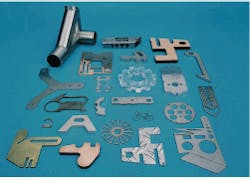CONFERENCE REVIEW: Industrial lasers show mettle at IMTS `98
CHICAGO, IL--Practical solutions to tough manufacturing problems were the highlights of the lasers and laser systems exhibit at the biennial International Manufacturing Technology Show (IMTS) in September. As an engineer at Bystronic (Hauppauge, NY) pointed out, show attendees were hungry for both higher laser power and greater flexibility—especially capability to machine parts of varying size and thickness in fewer setups (see photo).
Adaptive machining
Innovations promoted by industrial-laser vendors ranged from simple improvements in existing technology to new ways of doing business. For example, Trumpf Laser Div. (Livonia, MI) engineers can now boost processing capacity of some flat-sheet cutters by throwing two cutting heads at the task—production levels reach near-punch-press volumes at substantially less cost. Complex three-dimensional (3-D) machining applications also have gained from tweaking of key components, particularly nozzle technology. A new auto-focus head, for instance, adapts to changes in 3-D parts in real time, and the TLC 1005 five-axis laser cell permits operators to cut, weld, and partially harden parts with just one setup.
A more subtle, yet equally powerful, enhancement for the firm`s carbon-dioxide (CO2) laser-based flatbed cutters is a plasma-monitoring system. Instead of adding new sensors, Trumpf adapted capacitive-sensing technology long used for regulating height of the equipment`s z-axis to the task. The goal was to improve safety during high-speed processing of stainless steel.
Machining materials from 8 to 12 mm thick with more than 3000 W of laser power and nitrogen-assist gas is tricky business, often requiring the laser operator to monitor for plasma formation by listening as the laser cuts. Plasma formation is not only noisy, it also creates a small electrical field, which engineers tweaked the capacitive sensor and control software to monitor. If plasma formation is slight, the system reduces the feedrate of the laser briefly until formation stops; then cutting continues. If plasma formation is heavy, there is a brief axis stop until the plasma is extinguished, then cutting continues automatically with reduced acceleration.
Vision assists robot programming
In addition to introducing the Laserdyne 790 beamDirector system with five-axis beam motion that allows the part to remain stationary during processing, Lumonics (Livonia, MI) also improved fiberoptic beam delivery for Nd:YAG lasers. Its MultiWave-Auto system offers 4.5 kW at the laser source and 3.5 kW of maximum power at the workpiece throughout the lifetime of the lamps.
Also of note is a next-generation right-angle cutting head that fits through tighter spaces between fixtures and workpieces—instead of a 2-ft clearance, a robot now needs less than a foot. The head contains capacitive-sensing technology and is more rugged. Unlike units with a coaxial cable that must run all the way back to the machine controller, it has only a 10-in. cable running from the nozzle tip to the base of the head.
The new head design permits vision-assisted "teach" programming of robots with a simple off-the-shelf charge-coupled-device (CCD) camera. According to applications engineer Gerry Hermann, the improvements in teach-programming accuracy were unexpected. New to this head generation is a turning mirror coated to reflect the laser wavelength that remains fairly transparent to visible light. This allows the camera to look down through the lenses and the chip of the cutting head to provide visual position feedback.
"Typically, when teach-programming a robot, operators work with a red pointing laser beam coming out of the head tip," said Hermann. "This can align with scribe marks on the part within a millimeter of the programmed position. The camera provides positioning accuracy of less than a tenth of a millimeter, which can reduce programming time dramatically. After programming, the operator simply removes the camera, and the robot is production-ready."
Laser-marking systems also had a fairly strong presence at IMTS, with several laser vendors demonstrating semiconductor applications as well as traditional cutting and welding. For example, while Rofin-Sinar (Plymouth, MI) promoted an increase in power of its slab laser to 3 kW, the firm`s general manager Richard Walker also made sure booth visitors noticed the new diode-pumped laser-marking system.
Size of diode-pumped systems is not indicative of power—especially compared with Nd:YAG markers. According to Rofin-Sinar, its 103D diode-pumped marker has higher resolution--less than 2 µm—as well as a lens for marking a 70 × 70-mm area at high speed. Marking life is five to seven times that of the Nd:YAG systems, which are limited by lamp life. Compactness comes from design features such as air cooling so no chiller is needed.
About the Author
Paula Noaker Powell
Senior Editor, Laser Focus World
Paula Noaker Powell was a senior editor for Laser Focus World.
